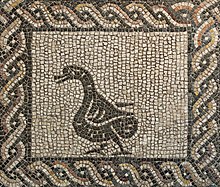Opus tessellatum


The opus tessellatum (Latin opus "work") is a technique in which mosaics are made from tesserae .
The opus tessellatum is usually used for backgrounds that consist of horizontally or vertically arranged lines - however, the stones are arranged either in horizontal or vertical lines, but not in a regular grid arrangement - that is, not aligned horizontally and vertically at the same time; that would then be the mosaic technique Opus regulatum .
However, not only the backgrounds, but also the motifs are laid using the opus tessellatum mosaic technique. The technique of Opus tessellatum is also typical for mosaics with an ornamental character.
Opus tessellatum was the most widely used mosaic technique among the ancient Greeks and Romans , early Christianity and the Byzantine Empire . They were a further development of the pebble stone mosaic technique in which unworked stones were used. Later some tesserae were used for the pebble mosaics to bring stronger colors into the motif. After all, people went to the eastern Mediterranean at least since the end of the 2nd century BC. About to design mosaics only with Tesserae. Initially, the Tesserae were made exclusively of marble, but in the 2nd century AD there were also those made of intensely colored glass. With the rise of the Roman Empire, the Opus tessellatum technique became popular in the 1st century BC. BC, especially in the Italian motherland, partly displaced by the more elaborate and expensive Opus vermiculatum technique. From the 1st century AD, mosaics in the opus tessellatum technique with figural motifs were increasingly used for complete floor mosaics. In the early Christian period, opus tessellatum became the predominant mosaic technique.
Other mosaic techniques
Other techniques for making mosaics are:
- Opus vermiculatum - elongated stones (vermis = Latin for worm, vermiculatum = worm-shaped), mainly used in figure compositions; smaller stones;
- Opus sectile
- Opus signinum - no mosaic technique, but a construction technique for floor design
Synonymous terms for solidified floors are
- Pavimentum Tessellatum: simpler, mostly two-tone mosaic floors, predominantly with geometric ornaments
- Pavimentum Vermiculatum
- Pavimentum Sectile
literature
- Marion Elizabeth Blake: The pavements of the Roman buildings of the Republic and early Empire. American Academy, Rome 1930
- M. Donderer: The ancient Paviment types and their names. In: Yearbook of the German Archaeological Institute 102 (1987). Pp. 365-377
- Walter Hatto Gross : Opus tessellatum. In: The Little Pauly (KlP). Volume 4, Stuttgart 1972, Sp. 575 f.
- Christoph Höcker : Metzler Lexicon of Ancient Architecture. 2nd Edition. Metzler, Stuttgart 2008, ISBN 978-3-476-02294-3 . P. 193